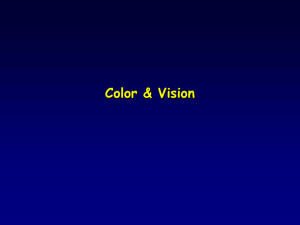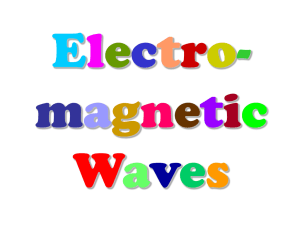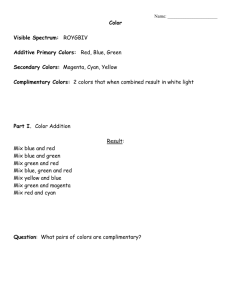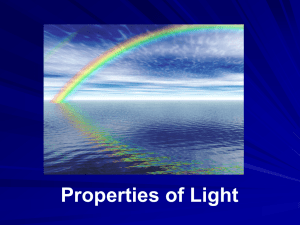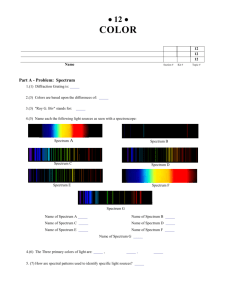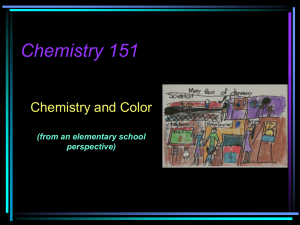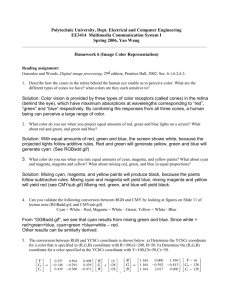What is light?
advertisement
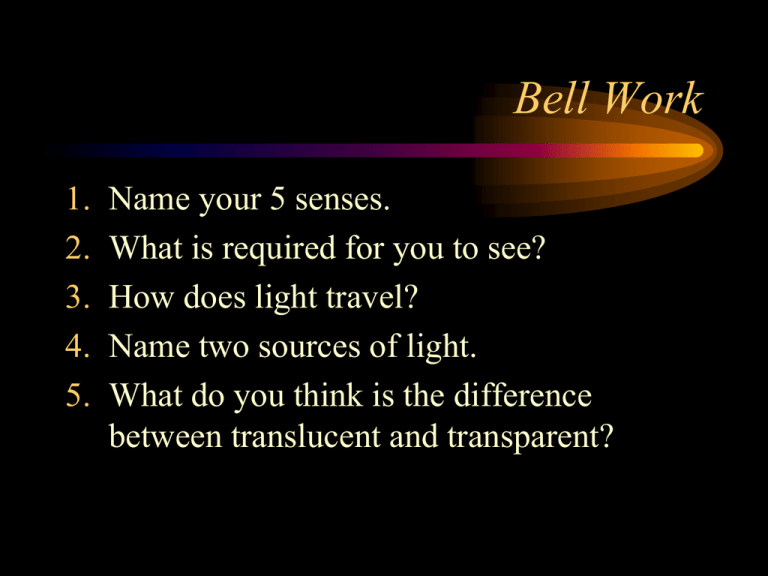
Bell Work 1. 2. 3. 4. 5. Name your 5 senses. What is required for you to see? How does light travel? Name two sources of light. What do you think is the difference between translucent and transparent? What is light? • Light is energy traveling as an electromagnetic wave • Visible Light - the range of frequencies of electromagnetic waves that stimulates the retina of the eye Electromagnetic Spectrum R O Y G B I V Red Orange Yellow Green Blue Indigo Violet (7 x 10-7 ) How does light travel? • Light travels in straight lines • We see this in shadows, flashlights • The ray model of light shows that a narrow beam of light travels in a straight line • Light exhibits the same wave properties we have studied: reflection, refraction, diffraction Sources of Light • The sun is our primary source of light • Incandescent bulbs, florescent bulbs, lasers, TV screens. LED bulbs Sources Sources of Light of Light • Luminous source: emits light waves (Sun, light bulb) • Illuminated source: reflects light waves (Moon) Light and Matter Types of Materials Transparent Translucent Opaque Transparent • Materials that transmit light waves • Examples: –air –glass –some plastics Translucent • Transmit light but do not permit objects to be seen clearly • Examples: –lamp shades –frosted glass Opaque • Transmit no light • Absorb or reflect all light waves Measurements of light • Eyes are sensitive to different wavelengths • Luminous flux (P)- rate that light is emitted from a source • Measured in LUMEN (lm) Example: A 100 W bulb = 1750 lumen Illuminance • The rate at which light strikes a surface, E • Think of this as the number of light rays (the amount of light) that strikes a surface • Measured in lux, lx • Maximum sunlight- 100,000 lux • Overcast day- 10,000 lux Candela • Candle power • Measure of light intensity • Lumen – measurement of light intensity • http://www.ted.com/talks/beau_lotto_optica l_illusions_show_how_we_see.html 1. How does light travel? 2. Name two sources of light. 3. What is the difference between a translucent and transparent object? 4. What is a standing wave? 5. What fraction of a wave is represented between the antinodes of a standing wave? 6. What is the basic wave equation? 7. What units are wavelength and frequency measured in? 8. Name three types of electromagnetic radiation. 9. Convert 4.2 cm to meters. 10. Light travels at a speed of 3.0 x 108 m/s. Calculate the frequency of light that has a wavelength of 5.8 x 10-7 m. Electromagnetic Spectrum • Light is energy emitted by accelerating electric charges (photons) • The energy travels in a wave that is both electric and magnetic • The range of waves, called electromagnetic waves, can travel through a vacuum or matter • When the light energy hits matter, the matter is forced into vibration Electromagnetic Spectrum • All waves on the spectrum are the same in nature • Low frequency radio waves behave the same as high frequency gamma rays • The waves have different frequencies and wavelengths • All electromagnetic waves travel at the same speed Visible Light • The lowest frequency of light we can see is red light • The highest frequency of light we can see is violet light • EM waves with frequencies lower than red light are called infrared • EM waves with frequencies higher than violet light are called ultraviolet Speed of Light • Galileo was the first to try to measure the speed of light • He measured the time it took for light to travel to a distant mirror and back • Time was too short to measure • Danish astronomer, Roemer made careful measurements using the periods of Jupiter’s moons • Albert Michelson, an American physicist, is credited with determining the speed of light in an experiment using rotating mirrors and a beam of light Speed of Light • The accepted speed of light is 3.0 x 108 m/s • This universal constant is denoted with the letter c • The speed of light is found with the same basic wave equation: c=λf Light Year • A beam of light is so fast that it could travel around the Earth 7.5 times in one second • It takes about 8 minutes for light to travel from the sun to the Earth • The distance light travels in one year is called a light-year Color Newton determined that white light was made from a combination of color The colors of the rainbow: ROYGBIV • Red • Orange • Yellow • Green • Blue • Indigo • Violet Additive Color Mixing • White light = RED LIGHT + GREEN LIGHT + BLUE LIGHT • These are considered Primary Light Colors • Yellow objects reflect yellow light, absorbs all other colors Adding colors • White light can be split up to make separate colors. These colors can be added together again. • The primary colors of light are red, blue and green Adding blue and red makes magenta (purple) Adding red and green makes yellow Adding blue and green makes cyan (light blue) Adding all three makes white again Secondary Light Colors • Formed by mixing primary colors –Yellow –Magenta –Cyan Complementary Colors • Two colors that add to produce white light –Cyan and Red –Magenta and green –Yellow and blue Seeing colour • The color an object appears depends on the colors of light it reflects. For example, a red book only reflects red light: White light Only red light is reflected A pair of purple pants would reflect purple light (and red and blue, as purple is made up of red and blue): Purple light A white hat would reflect all seven colours: White light Using colored light • If we look at a colored object in colored light we see something different. For example, consider the following: Shirt looks red White light Shorts look blue • In different colours of light these clothes would look different: Shirt looks red Red light Shorts look black Shirt looks black Blue light Shorts look blue Some further examples: Object Red socks Blue teddy Color of light Color object seems to be Red Red Blue Black Green Black Red Black Blue Green Red Green camel Blue Green Red Magenta book Blue Green Using filters • Filters can be used to “block” out different colors of light: Red Filter Magenta Filter Concept Check 1. The three primary colors of light are a) b) c) d) red, yellow, green Red, yellow, and blue Red, green, and blue Yellow, green, and blue 2. When red and green light shine on a white sheet, the resulting color is a) b) c) d) e) Blue Cyan Green Yellow Magenta 3. When red and blue light shine on a white sheet, the resulting color is a) b) c) d) e) Blue Cyan Green Yellow Magenta 4. Complementary colors are two colors that a) Look good together b) Are primary colors c) Are next to each other in the visible spectrum d) Produce white light when added together 5. The complementary color of blue is a) Red b) Cyan c) Green d) Yellow e) Magenta Color Blindness • http://colorvisiontesting.com/ishihara.htm Shadows • A shadow is formed where light rays cannot reach. • A total shadow is called an umbra. • A partial shadow is called a penumbra and appears when some of the light is blocked, but other light from another source fills in. Making Color by Subtraction • Objects can reflect and transmit light, and they can also filter light. • Colored filters transmit certain frequencies of visible light while absorbing others. • A blue filter absorbs red and green, a red filter absorbs green and blue, and the green filter absorbs red and blue. Filters • A filter can be used to block certain colors of light • Filters allow only certain frequencies to be transmitted. • http://www.michaelbach.de/ot/col_mix/inde x.html • A cyan filter absorbs red light, the magenta filter absorbs green light, and the yellow filter absorbs blue light. Combining filters • When a cyan (blue and green) and a yellow (red and green) filter are mixed, the color that results is green. • When cyan and magenta filters are mixed, blue results. • When yellow and magenta are mixed, red results. Dye • A dye is a molecule that absorbs certain wavelengths of light and transmits or reflects others. • When white light falls on a red block the dye molecules absorb blue and green, and reflect the red light. The object appears red to our eyes. • See image on page 441 in text. Primary Pigment • Pigments are like dyes except they are made of minerals. • Primary pigments absorb only one primary color of light. This means they reflect 2 colors of light. • The primary colors of pigments are yellow, cyan and magenta. • A color printer uses the primary colors of paint to produce any color imaginable. Secondary Pigments • A pigment that absorbs two colors of light and reflects one is a secondary pigment. • The secondary pigments are red, blue, and green. • The primary pigment colors are the secondary light colors and the secondary pigment colors are the primary light colors. Complementary Pigments • Red pigment is complementary to cyan. • Blue pigment is complementary to yellow. • Green pigment is complementary to magenta. • Complementary pigments are those that when mixed, result in a black color. 6. The cyan color of ocean water is evidence that the water absorbs __________light. a. Red b. Magenta c. Yellow d. Green e. blue 7. When magenta and cyan light are mixed, the resulting color is a. blue b. red c. green d. black 8. The mixing of cyan and yellow light to produce the color green is an example of color by a. addition b. subtraction c. none of the above, this is not possible 9. A sheet of red paper will look black when illuminated with ____light. a. red b. yellow c. magenta d. cyan 10. The color of an opaque object is determined by the light that is a. transmitted b. absorbed c. reflected d. all of the above 11. What color will a yellow banana appear when illuminated with blue light? a. red b. green c. yellow d. white e. black 12. What color will a yellow banana look when illuminated with green and red light? a. yellow b. blue c. white d. black 13. The primary pigments are a. red, blue, and green b. red, yellow, and green c. cyan, magenta, and yellow d. red, blue, and yellow 14. Complementary pigments are two pigments that result in a _____color when mixed. a. white b. black c. brown d. rainbow 15. The pigment complementary to magenta is ___. a. red b. blue c. yellow d. green Polarization of light • Non-polarized light (as in an incandescent bulb) vibrates in all directions • This means light waves are moving in multiple directions at the same time. • A single vibrating electron emits an electromagnetic wave that is polarized. • Polarized light oscillates in only one direction. Polarization • A polarizing filter blocks light in one direction. • Light moving in a horizontal plane can be blocked by a vertical filter. • Light moving in a vertical plane can be blocked by a horizontal filter. Polarization by Reflection • Light reflected off surfaces is partially polarized. • The light is polarized in the same plane as the surface. • Glare from a horizontal surface is horizontally polarized. • Which pair of sunglasses is best suited for automobile drivers? Pair C is best suited because the vertical polarization axis blocks horizontally polarized light coming from the road. Polarized Light and 3D Viewing • Vision in three dimensions depends on the fact that both eyes give impressions simultaneously • Each eye views a scene from a slightly different angle • The combination of views in the eye-brain system give depth 3D Movies • A movie can be seen in 3D when the left eye sees the left view and the right eye sees only the right view. • This is accomplished by projecting a pair of polarizing filters at right angles on the screen. • The overlapping pictures look blurry to the naked eye. • To see in 3D the viewer wears polarizing glasses with the lens axes also at right angles. • Each eye sees a separate picture • The brain interprets the two pictures as a single image with a feeling of depth. 16. Light reflected from a lake surface is polarized ______. a. vertically b. horizontally c. randomly 17. In order for sunglasses to be effective in reducing glare produced from a road, the lasses should be polarized ____. a. vertically b. horizontally c. both vertically and horizontally 18. Glasses used for 3D viewing are polarized a. vertically b. horizontally c. both vertically and horizontally 19. If two polaroid filters are held with their polarization axes at right angles to each other, the amount of light transmitted compared to when their axes are parallel is ___. a. twice as much b. the same c. half as much d. zero 20. Non-polarized light vibrates a. vertically b. horizontally c. in all directions
